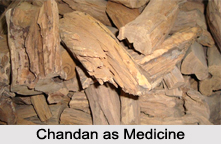 In Ayurveda, Santalum Album is known as "Chandan". Sanskrit writers describe several varieties of chandana and some include the woods of Pterocarpus Santalinus (Raktachandana) and Caesalpinia Sappan (pattanga) under this common denomination. Excluding these last, two varieties of sandal wood are generally recognised, namely, srikhanda or white sandal wood and pitachandana or the yellow variety. These varieties are founded on the difference in the depth of colour in the heart-wood and not on any specific difference in the plants.
In Ayurveda, Santalum Album is known as "Chandan". Sanskrit writers describe several varieties of chandana and some include the woods of Pterocarpus Santalinus (Raktachandana) and Caesalpinia Sappan (pattanga) under this common denomination. Excluding these last, two varieties of sandal wood are generally recognised, namely, srikhanda or white sandal wood and pitachandana or the yellow variety. These varieties are founded on the difference in the depth of colour in the heart-wood and not on any specific difference in the plants.
Health Benefits of Chandan
Sandal wood is described as bitter, cooling, astringent, and useful in biliousness, vomiting, fever, thirst and heat of body. An emulsion of the wood is used as a cooling application to the skin in erysipelas, prurigo and sudamina.
Dose of Chandan in Medicine
2 tolas of the watery emulsion of sandal wood, with the addition of sugar, honey and rice-water is given to check gastric irritability and dysentery, and to relieve thirst and heat of body.
Various Use of Chandan
The use of sandal wood in carving and the elegant and fragrant articles made from it are very famous. The Hindus use an emulsion of the wood in the worship of their idols and for painting or anointing their bodies after bathing. Rich natives sometimes use sandal wood for burning their dead relatives. Rich or poor, all add at least one piece of the wood to the funeral pile.
The essential oil of Chandan obtained by distillation from the heart-wood and roots is of a pale yellow colour and has a peculiar fragrant smell. It is much used as a perfume by the Hindus both for themselves and for their idols. In Odisha, it is a practice with the better classes to rub a little sandal oil in the spices which they take with their betel-leaf.
This article is a stub. You can enrich by adding more information to it. Send your Write Up to content@indianetzone.com
Related Articles
Ayurveda
Ayurveda Medication
Sushruta Samhita
Classification of Medicine
Properties of Material Objects and its Effect on Human Body
Taila
Ghrita
Asava and Arishta
Dravaka
Kanjika




















